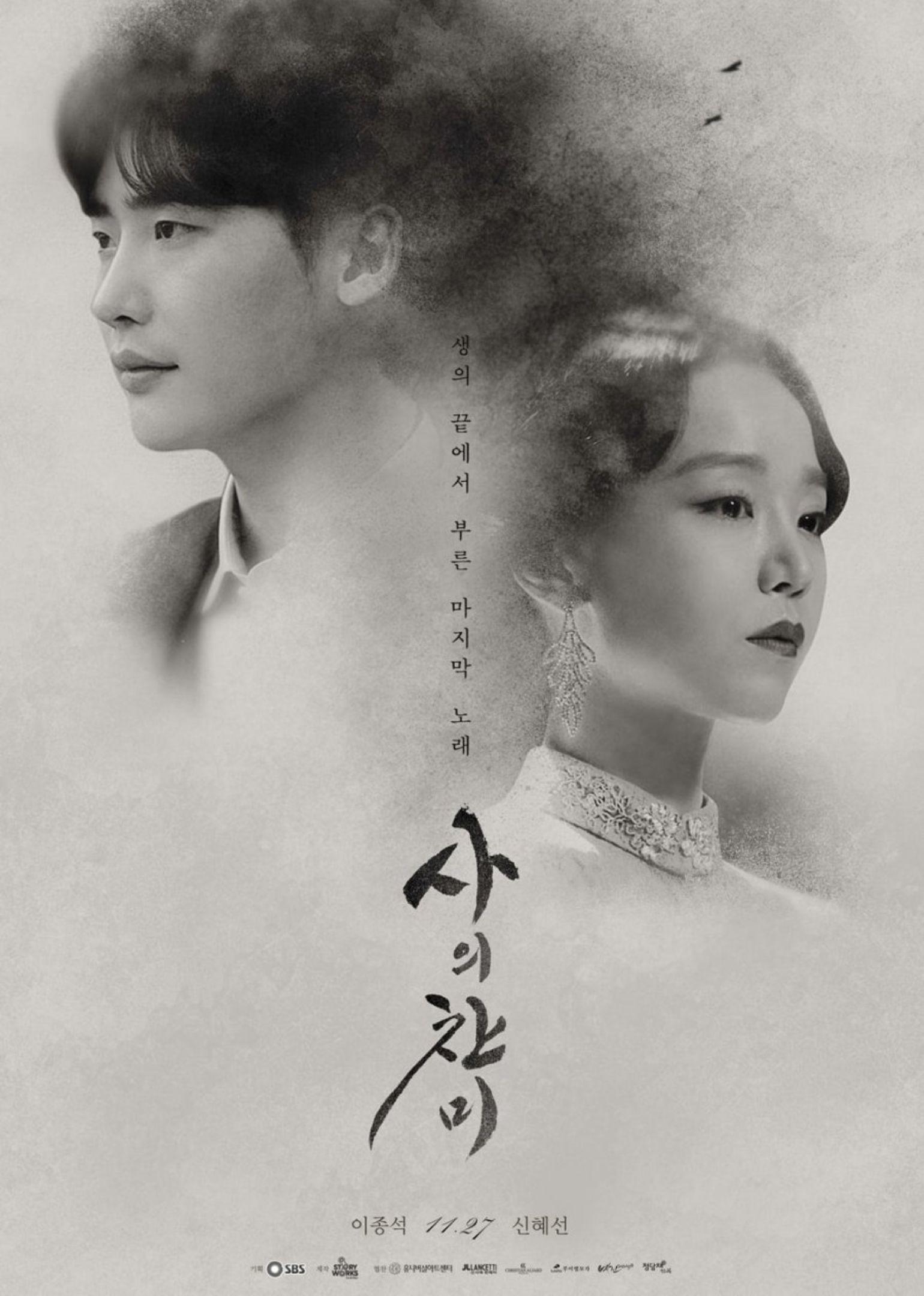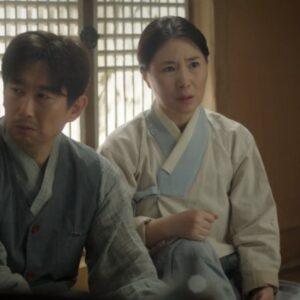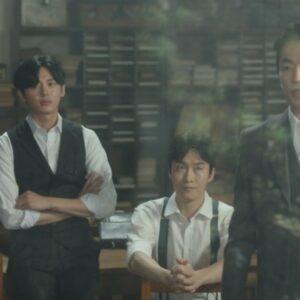
The Hymn of Death
Set during Korea’s Japanese colonial era, The Hymn of Death tells a haunting true story of love, sacrifice, and art. Lee Jong Suk stars as Kim Woo Jin, a married playwright torn between duty and passion, while Shin Hye Sun plays Yun Sim Deok, Korea’s first professional soprano. Their connection, born out of a shared love for literature and music, blossoms into a deeply emotional yet forbidden romance. Despite the suffocating social norms and political unrest of the 1920s, Sim Deok and Woo Jin find solace in each other’s presence. Their secret affair fuels their creativity, resulting in poignant compositions and performances that reflect their inner turmoil. Sim Deok’s haunting song “Praise of Death” becomes the anthem of their love and despair, forever etching their story into Korea’s cultural memory. As pressure mounts from all directions—family, society, and the harsh realities of life under occupation—the couple faces impossible choices. Their tragic love story, shaped by a longing to live freely and love fully, culminates in a heart-wrenching decision that shocks the nation and leaves a lasting legacy. The Hymn of Death is a short but emotionally rich Korean drama that masterfully blends historical events with timeless human emotion. With powerful performances by Lee Jong Suk and Shin Hye Sun, the series offers a cinematic tribute to two real-life artists who chose love over survival. It’s a must-watch for fans of tragic romances, historical K-dramas, and true stories that echo through generations.
Details
🙂 Native Title: 사의 찬미
🌎 Also Known As: Praise of Death, Hymn of Death, Death Song
🎭 Genres: Romance, Historical, Drama, Music, Tragedy
🏷 Tags: Based on True Story, Star-Crossed Lovers, Joseon Era, Forbidden Love, Classical Music
✍ Screenwriters: Jo Soo Jin
🎬 Directors: Park Soo Jin
🇰🇷 Country: South Korea
🎬 Episodes: 6
🗓️ Aired: November 27, 2018 – December 4, 2018
📅 Airing Days: Monday & Tuesday
📺 Original Network: SBS
⏰ Duration: 35 minutes per episode
🔞 Content Rating: 15+ – Teens 15 or older
Best Scenes
-
Woo Jin and Sim Deok’s final farewell on the ship is one of the most emotional moments, symbolizing love, despair, and irreversible fate.
-
Sim Deok singing “Praise of Death” live captures both historical importance and emotional depth, leaving a lasting impact.
-
The first stage rehearsal where Woo Jin sees Sim Deok perform is filled with silent admiration and romantic tension.
-
Woo Jin’s monologue about love and destiny provides insight into his internal conflict and intensifies the drama’s poetic tone.
-
Sim Deok’s confrontation with her family reveals the pressure of tradition and the strength it takes to chase her dreams.
Filming Locations
-
Daehangno Theater District in Seoul was used to recreate 1920s Korean performance scenes.
-
Gyeongju Historic Areas provided authentic Joseon-era backdrops, enhancing the period drama’s realism.
-
Incheon Open Port Area was featured in scenes depicting colonial Korea, with preserved architecture from the early 20th century.
-
Yongma Land, an old amusement park, was subtly adapted to represent Woo Jin’s nostalgic memories.
-
Jeonju Hanok Village was used to reflect traditional Korean aesthetics in family and hometown scenes.
Visual Design and Costumes
-
Sim Deok’s elegant hanbok and vocal dresses highlight her transformation from a dutiful daughter to an iconic soprano.
-
Woo Jin’s muted suits and vintage glasses reflect his artistic, introspective personality and the era’s fashion.
-
Pale and sepia-toned cinematography enhances the tragic and nostalgic tone of the story.
-
Art direction mimics early 20th-century Korea, with great attention to detail in furniture, props, and set design.
-
Symbolic use of rain and water imagery amplifies emotions, especially during scenes of heartbreak and longing.
Themes and Messages
-
Love versus societal expectations is the central conflict, as the leads fight for a future that the world forbids.
-
Art as a form of resistance — both Woo Jin and Sim Deok express suppressed emotions through music and literature.
-
The tragedy of genius unrecognized in its time mirrors real historical figures who died too soon.
-
Patriotism and cultural identity under Japanese rule are subtly embedded in their struggle for expression.
-
Mortality and legacy — the drama explores what it means to leave behind more than a memory.
Interesting Facts
-
The Hymn of Death is based on the real-life romance between Yun Sim Deok and playwright Kim Woo Jin.
-
Lee Jong Suk and Shin Hye Sun reunited after starring together in School 2013, adding fan anticipation.
-
Sim Deok’s actual song “Praise of Death” is considered Korea’s first pop recording, made in 1926.
-
The drama’s short 6-episode format was praised for its powerful storytelling and historical depth.
-
Shin Hye Sun underwent vocal training to realistically portray an opera singer, showcasing her dedication to the role.
Awards
The Hymn of Death (2018) has not received any major awards. However, the series has been praised for its poignant storytelling, strong performances by Lee Jong Suk and Shin Hye Sun, and its faithful portrayal of a tragic real-life romance. The drama’s emotional depth and historical significance have resonated with audiences, making it a memorable entry in the realm of Korean television.
Real-Life Loves on Set
Yes, The Hymn of Death is based on a real-life tragic romance. The story depicts the true relationship between Yun Sim Deok, Korea’s first professional soprano, and Kim Woo Jin, a talented playwright during the Japanese occupation of Korea.
Their love was real and deeply emotional but ultimately forbidden. Kim Woo Jin was married, and the societal norms of the time made their relationship scandalous. Despite the odds, they pursued a passionate and artistic connection. In 1926, they both chose to end their lives together by jumping into the sea from a passenger ship returning to Korea — an event that shocked the nation.
Their romance has since become one of Korea’s most well-known and heartbreaking love stories, symbolizing both the power and tragedy of love constrained by society. The drama beautifully portrays this historical connection, making it all the more poignant and memorable.















